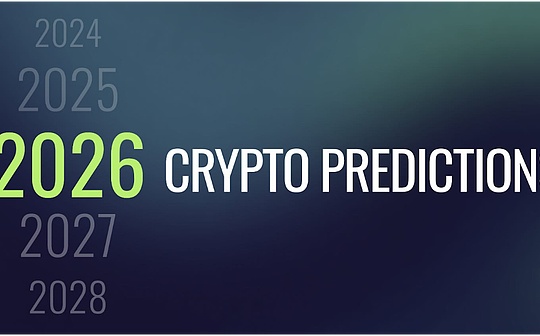
Author: Vitalik, founder of Ethereum; compilation: Deng Tong, Bitchain Vision
Press: This article is the third part of the “Ethereum Agreement” series of articles in the “Ethereum Agreement” series of articles “The Future Development of the Ethereum Agreement” series of Ethereum founder Vitalik “”>Possible Futures of the Ethereum Protocol, Part 3: The Scourit“.>Vitalik: how should the Ethereum protocol develop in the Surge stage“, See the first part”What else can be improved by Ethereum POS“. The following is the full text of the third part:
One of the biggest risks faced by Ethereum L1 is the centralization of equity proof caused by economic pressure.If there is a scale economy in the core rights certificate mechanism, this will naturally lead to the dominant position of large -scale stakeholders, and those with small interests will withdraw from the large -scale mining pool.This leads to a higher risk of 51% attack, transaction review and other crises.In addition to centralized risks, there is also the risk of value extraction: a small number of people have obtained the value that originally flowed to Ethereum users.
Last year, our understanding of these risks greatly increased.It is well known, “This risk exists in two key places: (i) block construction, and (ii) pledge capital regulations.Larger participants can run more complicated algorithms (“MEV extraction”) to generate blocks, thereby bringing higher block income.Large -scale participants can also release funds as a mobile pledged token (LST) to others, which can more effectively solve the inconvenience of being locked in funds.In addition to the direct problems of small pledges and large pledges, there are also the problem of (or will) too much pledge ETH.

Scourt 2023 roadmap
This year, major progress has been made in block construction. The most significant thing is that the “committee includes a list plus some targeted sorting solutions” as the integration of the ideal solution, as well as important research on equity proof of economics, including two floors, etc.The ideological pledge model and reduce the amount of circulation to limit the percentage of pledge ETH.
The scourgy key goal
-
Try to reduce the centralized risk of the Ethereum pledged layer (especially in terms of block construction and capital supply, they are also called MEV and pledge pools)
-
Try to minimize the risk of excessive squeezing value from users
This article is divided into three parts
-
Fixing the block construction pipeline
-
Fixing Staking Economics
-
Application-Layer Solutions
Repair block construction
What problems do we have to solve?
Today, the Ethereum block construction is mainly completed by separation of the Propser-Builder outside the MEVBOOST protocol.When the verifications have the opportunity to propose a block, they will allocate the work of choosing the block content to the specialty participant called the builder.The task of choosing the block content that maximizes the income is large -scale economy -intensive: require special algorithms to determine which transactions to be included in order to extract as much value as possible from the chain financial instruments and interactive user transactions (This is the so -called “MEV extraction”).Verivers are facing the “DUMB-PIPE” task of relatively lighter economy, that is, supervision listening to the bid and accepting the highest bid, and other responsibilities such as proof.

MEVBOOST is a programmatic diagram: Specialized builders undertake red tasks, and stakeholders assume blue tasks.
There are many versions, including the “proposal-builder separation” (PBS) and “proof-proposal separation” (APS).The difference between them is related to the details of Finegraine, which is the responsibility of which responsibilities which one among the two participants: roughly, in PBS, the verifications still propose blocks, but they receive effective loads from the builder, and and the valid load, and and the effective load, and the valid load, and the valid load, and the effective load, and the effective load, and the valid load, and the valid load, and the valid load, and the valid load, and the valid load, and the valid load, and the valid load,, to receive effective loads, and the valid load, andIn APS, the entire slot has become the responsibility of the builder.Recently, APS is more popular than PBS because it further reduces the motivation of the proposal and the builder.Please note that APS is only applicable to executing blocks containing transactions; consensus blocks that include relevant data (such as proof) including equity proof will still be randomly distributed to verifications.
This separation of power helps to maintain the decentralization of the verifications, but it has an important cost: participants who perform the “specialized” task can easily become very centralized.This is today’s Ethereum block construction:
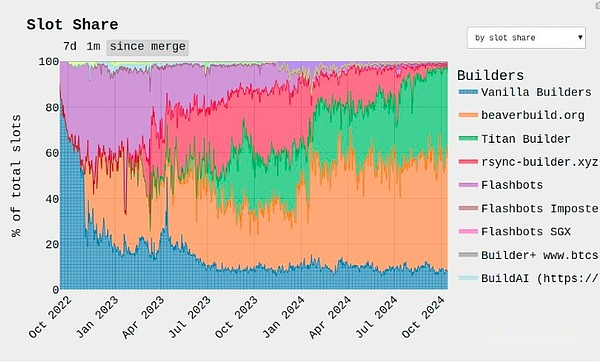
Two participants are choosing about 88% of Ethereum blocks.What if these two participants decide to review the transaction?The answer is not as bad as it looks: they cannot reorganize the blocks, so you don’t need 51% censorship to prevent transactions from being included: you need 100%.Under the 88% censorship mechanism, users need to wait for 9 grooves on average (technically, an average of 114 seconds instead of 6 seconds).For some cases, wait for some transactions for two or even five minutes.But for other use cases, such as in DEFI liquidation, it is a major market manipulation risk even if it can delay the transaction of other people’s transactions.
The strategy of block builders can be used to maximize income may have other negative impacts on users.”Sandwich attack” may lead to major losses due to slippery points for tokens.The transactions introduced in order to make these attack chains have increased the prices of other users.
What is it and how does it work?
The leading solution is to further decompose block production tasks: we re -handed the task of choosing the transaction to the proposal (that is, the pledker), and the builder can only choose to sort and insert some of its own transactions.This is what contains the list to do.
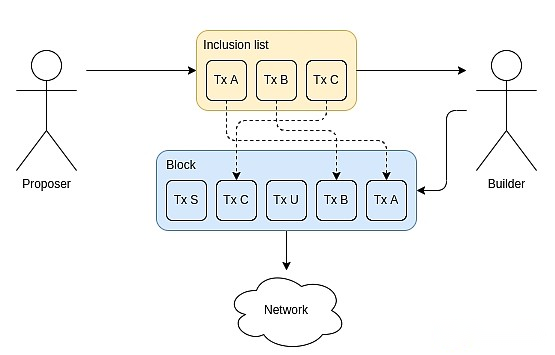
In time T, the random selected pledker created a list containing a list, that is, an effective trading list in the current state of the blockchain.In time T+1, the block builders (maybe in advance through the auction mechanism in the agreement) create a block.This block needs to contain each transaction in the list, but they can choose the order and can add their own transactions.
The fork selects a committee that contains a list of compulsory lists (FOCIL) proposals involving each block containing a list of creators composed of list creators.In order to delay the transaction in one block, the K (such as K = 16) of the k (such as K = 16) must be reviewed.The combination of FOCIL and the final proposal selected by the auction needs to include a list, but it can re -sort and add new transactions, usually called “Focil + APS”.
Another way to solve this problem is multiple concurrent proposals (MCP) solutions, such as BRAID.BRAID tries to avoid dividing the role of block proposals into low -scale economic parts and high -scale economic parts. Instead, trying to allocate block production processes to many participants, so that each participant proposal only needs to have a moderate degree of complexityThey can maximize their income.The working principle of the MCP is to allow the K -parallel proposal to generate a trading list, and then use the certainty algorithm (for example, sorting from high to low) to select the order.

BRAID does not seek to achieve the best goal of the Dumb-PIPE block proposal to achieve the default software.The two reasons for which it cannot be done is::
-
Later arbitrage attack:Assuming the average time submitted by the proposal is T, and the time you may submit and still be included in is about T+1.It is now assumed that on a centralized exchange, ETH/USDC prices are from $ 2,500 to $ 2502 between T and T+1.The proposal can wait a second more, and then add additional transactions to arbitrage the decentralized exchange on the chain, and each ETH can get a profit of up to $ 2.Sophisticated proposals who have a good connection with the Internet are more capable of doing this.
-
Ekou order flow:Users have the motivation to send the transaction directly to a single proposal to minimize their vulnerability to suffer their first trading and other attacks.Experienced proposals have advantages, because they can establish infrastructure to accept these transactions directly from users, and they have a stronger reputation. Therefore, users who send them to them can believe that the proposal will not betray and trades first (thisIt can alleviate the use of credible hardware, but credible hardware has its own trust assumptions.)
In Braid, proofers can still be separated and run as Dumb-PIPE function.
In addition to these two extremes, there are also a series of possible designs between the two.For example, you can auction only the right to add to the block, and there is no right to sort or be front.You can even let them be attached or front, but cannot be inserted in the middle or sorted.The attractiveness of these technologies is that the winners of the auction market may be very concentrated, so there are many benefits to reducing their authority.
Memory pool encryption
For many such designs (specifically, the BRAID or APS version, which is strictly limited to the auction function) is the key to encrypted memory pool.Crypto memory pools are a technology that broadcasts its transactions in the form of encryption and attachs some validity proof, and the transaction is included in the block in the form of encryption, while the block builders do not know their content.The transaction content was announced later.
The main challenge to realize the encrypted memory pool is to propose a design to ensure that all transactions will be disclosed later: the simple “submission and disclosure” solution will not work, because if the disclosure is voluntarily, the behavior of choosing to disclose or not disclosed is itself itselfOn a “final promoter” of the use of blocks that can be used.The two main technologies are (i) threshold decryption and (ii) delay encryption. This is a primitive that is closely related to verified delay functions (VDF).
What are the connections with existing research?
MEV and constructifier centralized interpretation:>https://vitalik.eth.limo/general/2024/05/17/Decentralization.html #Mev-nd-builder-dependnce
MevBoost:>>>>>>>>>>>>>>>>>>>>>>https://github.com/flashbots/mev-boost
ENSHRINED PBS (solution to these problems in the early days):
Mike Neuder contains list -related readings:https://gist.github.com/michaelneuder/dfe5699cb245BC99FBC718031C773008
Including list EIP:>https://eips.ethereum.org/eips/eip-7547
Focil:https://ethresear.ch/t/Fork-choice-nforced-founds-Focil-A-SIMIMITTEE-BASED-Inclusion-PROPOSAL/19870
MAX Resnick’s Braid Demonstration:https://www.youtube.com/watch?v=mjlerwmq2uw
“Priority is what you need”, author: Dan Robinson:https://www.paradigm.xyz/2024/06/priority-s-all-d
About multiple proposals and small tools and protocols:>>https://hackmd.io/xz1uykSetr-PCSAZEPMAJW
Vdfresearch.org:>https://vdfresearch.org/
Veried delay functions and attacks (focus on RANDAO settings, but also applies to encrypted memory pools):
MEV execute ticket capture and decentralization:https://www.arxiv.org/pdf/2408.11255
APS centralization:https://arxiv.org/abs/2408.03116
Multiple MEVs and lists:https://x.com/_charlienoyes/status/1806186662327689441
What else do you need to do and what do you need to weigh?
We can consider all the above plans as different ways to divide the authority to participate in Stake, and arrange in accordance with the scope of the scope from the low-scale economy (“Dumb-Pipe”) to a high-scale economy (“professionalized friendship”).Before 2021, all these permissions were tied to a participant:
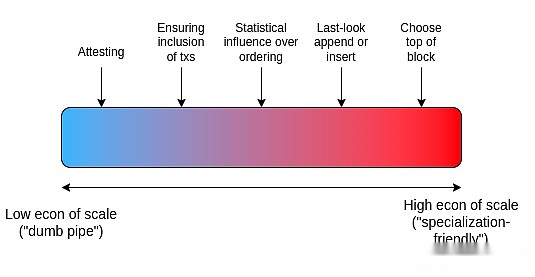
The core problem is: any meaningful power that is still in the hands of stakeholders may eventually become a “MEV -related” power.We hope that a set of highly scattered participants will have as much power as possible; this means that (i) hand over a large amount of power to stakeholders, and (ii) to ensure that the stakeholders are as decentralized as possible, which means that they almost almostThere is no integrated incentive measure of large -scale economy -driven economy.This is a kind of tension that is difficult to cope.
A special challenge is multi -block MEV: In some cases, if the auction winner continuously captures multiple grooves, and is not allowed to perform any MEV -related blocks in the last block where they controlsThey can make more money.If the list forced them to do this, then they can try to bypass it by not publishing any block in these periods.People can make unconditional lists. If the construct is not provided, the list will be directly become a block, but this makes the list related to MEV.The solution here may involve some compromises, including accepting some low -degree incentives to bribe people to include the transaction included the list.
We can view FOCIL + APS as follows.The pledgee continues to have the power on the left side of the spectrum, while the right side of the spectrum is auctioned to the highest bid.

Braid is completely different.The “pledged” part is even larger, but it is divided into two parts: light pledgers and heavy pledges.At the same time, because the transaction is arranged in order of preferences, the selection of the top of the block is actually auctioned through the cost market. This solution can be considered similar to PBS.

Please note that the security of BRAID depends to a large extent on the encrypted memory pool; otherwise, the top auction mechanism is vulnerable to strategic stolen attack (essentially: copy other people’s transactions, exchange the receiver address, and pay 0.01 0.01% Of high costs).This demand for pre -inclusive privacy is also so difficult to implement PBS.
Finally, Focil + APS’s more “radical” version, such as.The options at the end of the APS are only as shown in the options at the end of the block:

The remaining main tasks are (i) dedicated to consolidating various proposals and analyzing its consequences, and (ii) combining this analysis with the understanding of the goal of the Ethereum community, that is, what form of the form of tolerance will tolerate what form of the form of toleranceEssenceEach separate proposal needs to be completed, such as:
-
Continue to the design of encrypted memory pools and reach this level: Our design is both stable and simple, and it seems that it is ready to be included.
-
Optimize multiple designs including lists to ensure that (i) will not waste data, especially in the context containing the Blob, and (ii) friendly to a state -free verification device.
-
About more work on APS optimal auction design.
In addition, it is worth noting that these different proposals are not necessarily incompatible forks.For example, the implementation of FOCIL + APS can easily be used as a scootstone for implementing BRAID.An effective conservative strategy is the “watching” method. We first implement a solution. Among them, the authority of the pledgers is restricted, most of the permissions are auctioned, and then with time, as our MEV market operation on the real -time network is pushed, the operation of the MEV market on the real -time network is operating.Learn more and slowly increase the power of stakeholders.
In particular, the centralized bottleneck of pledge is:
-
Block construction centralization (this section)
-
For economic reasons, the centralization of pledge (next section)
-
Due to the minimum limit of 32 ETH, the pledge is centralized (solved through ORBIT or other technologies; please refer to the relevant>mergePost)
-
Rebuilding pledge due to hardware requirements (in Verge, through the stateless client and the later ZK-EVM solution)
Solving any of these four problems will increase the benefits of solving any other problems.
In addition, there is an interaction between the constructing pipeline and the final design of the single slot, especially when trying to reduce the time clearance time.Many block construction pipeline design will eventually increase time clearance.Many block construction pipes involve the role of proofers in multiple steps of the process.Therefore, it is worth considering the final nature of block construction pipelines and single slots.
Repair pledge economics
What problems do we have to solve?
Today, about 30% of ETH supply is actively pledged.This is enough to protect Ethereum from 51% attack.If the proportion of ETH pledged becomes larger, researchers are worried that there will be different situations: if almost all ETHs are pledged, risks will occur.These risks include:
-
The task of pledge from an expert in the expert has become the responsibility of all ETH holders.Therefore, ordinary pledges will be more enthusiastic and choose the simplest way (in fact, entrust their token to the most convenient centralized operator)
-
If almost all ETHs are pledged, the credibility of the reduction mechanism will weaken
-
A single -class pledged pledge can be taken over most of the equity, and even takes over ETH’s “currency” network effect
-
Ethereum does not need to issue an additional 1 million ETH every year.In a case of a liquidity for the dominant network effect, a large part of the value may even be captured by LST.
What is it and how does it work?
Historically, a type of solution is: if everyone is unavoidable for pledge and the liquidity pledged token is inevitable, then let us make the pledge be friendly, so that it is actually trusted, and it is actually trusted.Neutral and maximum decentralized liquid pledged tokens.A simple method is to limit the pledge punishment to 1/8, which will make 7/8 pledge ETH unreabing, so it is eligible to put the same liquidity pledged tokens.Another choice is to clearly create two -layer pledge: “bearing risks” (reduced) pledge.
However, a criticism of this method is that it seems to be more economical in economics: if the equity is close to a pre -determined upper limit, it will greatly reduce the circulation.The basic argument is that if we finally enter a world with a risk -undertaking layer return rate of 3.4% and a world with no risk layer (everyone involved) is 2.6%, then the same return rate as the world of pledged ETH is 0.8%, Only the ETH return rate is 0%.The dynamics of risks, including total pledge and centralization, are the same in both cases.So we should do simple things and reduce the distribution.
The main refutation to this argument is whether we can still have some useful effects and a certain degree of risks (for example, as Dankrad proposed here).
Both suggestions mean changing the issuance curve. If the number of equity is too high, the return rate will be extremely low.

Left: Justin Drake proposed a proposal to adjust the distribution curve.Right: Another group of proposals proposed by Anders Elowsson.
On the other hand, the two -level pledge needs to set up two returns curves: (i) the return rate of pledge (i) “basic” (risk -free or low risk) pledge, and (ii) has a premium of risk pledge.There are many ways to set these parameters: for example, if you set a hard parameter, that is, the equity of 1/8 is reduced, then the market dynamics will determine the premium of the return rate obtained by the equity.
Another important theme here is MEV capture.Today, MEV’s income (such as DEX arbitrage, sandwiches …) flows to the proposal, the pledker.This is the revenue of the agreement completely “opaque”: the agreement cannot know whether it is 0.01% annual interest rate, 1% annual interest rate or 20% annual interest rate.From multiple perspectives, the existence of this source of income is very inconvenient:
-
This is an unstable source of income, because each interest -related person can only get it when proposed a block, and now it is now about every 4 months.This will inspire people to join the fund pool to obtain more stable income.
-
It leads to imbalanced incentive distribution: too much proposal is proved too little.
-
This makes it difficult to implement the upper limit of the equity: even if the “official” return rate is zero, the MEV income alone may be enough to promote all ETH holders to pledge.Therefore, the real estate upper limit proposal must actually make the return close to the endless negative.This brings more risks to pledges, especially separate pledges.
We can solve these problems by finding a way to make MEV income clearly visible to and capture it in the protocol.The earliest proposal was the Mev Smoothing of Francesco; now, people generally believe that the rights of any proposal for early auction blocks (or more generally have enough power to capture almost all MEVs) can achieve the same goals.
What are the connections with existing research?
Issuing WTF:>https://issuance.wtf/
ENDGAME pledge economics, positioning case:https://ethresear.ch/t/endgame-stake-eConomics-Case-For-targetIn/18751
Release level attributes, Anders ElowsSon:https://ethresear.ch/t/properties-ill-level-Consensus-ndariability-ACROSS-Reward-curves/18448
The upper limit of the verification device settings:https://notes.ethereum.org/@vbuterin/single_slot_finality?=View #economic- Capping–Total-deposits
Thinking about multi -layer pledge thoughts:https://notes.ethereum.org/@vbuterin/stake_2023_10?Type=view
Rainbow pledge:https://ethresear.ch/t/unbundling-stake-towards-rainbow-stake/18683
Dankrad’s mobile pledge proposal:https://notes.ethereum.org/pcq3m8b8tuwnesuhkwcsfg
Mev Smoothing, Author: Francesco:https://ethresear.ch/t/committee-driven-Mev-smoothing/10408
MEV BURN, Author: Justin Drake:https://ethresear.ch/t/mev-aburn-a-simple-design/15590
What else do you need to do and what do you need to weigh?
The remaining main tasks are either agreed not to take any actions and accept the risk of almost all ETH in LST, or finally determine and reach the details and parameters of one of the above proposals.The general summary of the income and risk is as follows:
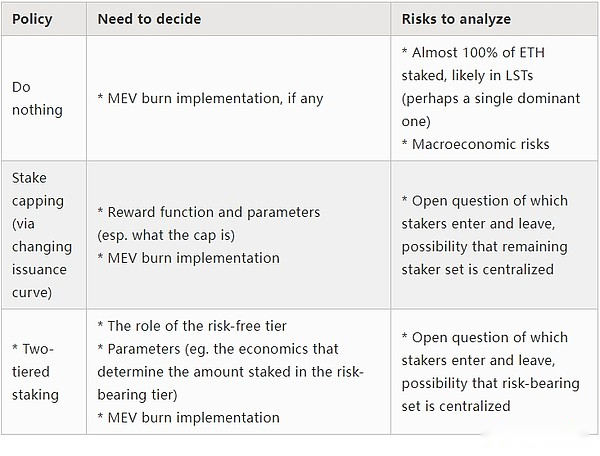
How can it interact with other parts of the roadmap?
An important cross point is related to separate betting.Today, the cheapest VPS per month that can run the Ethereum node is about $ 60, mainly due to hard disk storage costs.For 32 ETH pledges ($ 84,000 in this article), this will reduce APY (60 * 12) / 84000 ~ = 0.85%.If the total pledge return rate is less than 0.85%, it is not feasible for many people at this level.
If we want to continue to pledge alone, it will further emphasize that the need to reduce the operating cost of node, which will be completed in VERGE: there willInsufficient.
On the other hand, MEV destruction can be said to help separate pledge.Although it reduces the return of everyone, it is more important to reduce the difference, so that the pledge is no longer like a lottery.
Finally, any change issued will interact with other fundamental changes in pledged design (such as rainbow pledge).A particular issue worthy of attention is that if the pledge return becomes very low, this means that we must make a choice between the following two: (i) to reduce the punishment and reduce the inhibitory factors of bad behaviors; (ii) Keep maintenanceHigher punishment, which will add a series of situations even if it is a kind of verifiable, if unfortunately encounter technical problems or even attack, it will accidentally get negative returns.
Application layer solution
The above points focuses on the changes in Ethereum L1, which can solve important centralized risks.However, Ethereum is not just a L1. It is an ecosystem, and there is an important application layer strategy to help reduce the above risks.Some examples include:
-
Special pledge hardware solution—— Some companies (such as DappNode) are selling hardware specially designed in order to operate pledge nodes as easily as possible.One of the ways to make this solution more effective are to ask a question: If the user has spent energy to let a box run and connect to the Internet, which other services can it provide to benefit from the decentralization of power?The examples I thought include (i) the master’s degree in law for local custody for self -sovereignty and privacy reasons, and nodes of (ii) running decentralized VPN.
-
Team pledge——Mo-Obol’s solution allows multiple people to pledge together in the M-OF-N format.Over time, this may become more and more popular, because no state and later L1 EVM validity proof will reduce the cost of running more nodes, and each participant does not need to worry about the benefits of always online occupation of dominance to start dominating leadership.status.This is another method of reducing pledge recognition overhead and ensuring that the pledge of separate pledge will flourish in the future.
-
airdrop—— Starknet provides airdrops to individual pledges.Other projects that want to have decentralized and consistent values can also be considered to provide airdrops or discounts from verificationrs who are determined to be a separate equity holder.
-
Decentralized block construction market——In the combination of ZK, MPC and Tee, you can create a decentralized block builder to participate and win APS auction games, but at the same time provide users who pre -confirmed privacy and anti -review to ensure it.This is another way to improve user benefits in the APS world.
-
Minimalization of application layer MEV——S single application can be constructed by “leakage” less MEV to L1, thereby reducing the power of block builders to create special algorithms to collect MEV.A simple but universal strategy is to put all the contractual operation into the queue and execute it in the next block, and auction the right to cut into line, although it is not convenient and destroyed.Other more complicated methods include more work under the chain, such as.Just like what COWSWAP does.The prophecy machine can also be redesigned to minimize the value of the prediction machine’s extraction.
Thank you for the feedback and review of Justin Drake, Caspar Schwarz-Schilling, Phil Daian, Dan Robinson, Charlie Noyes, and Max Resnick, as well as discussions from the ETHSTAKERS community.

